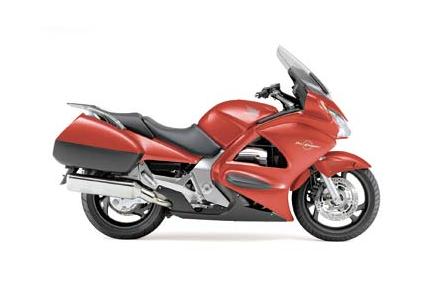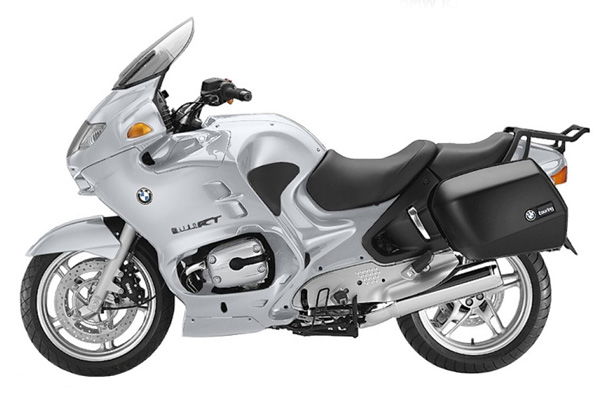R1200RT (2005 - present) review
The new R1200 RT improves on the old bike’s talents with a sharper motor and better handling. It should be a winner

So what’s new this year? Well, continuing BMW’s ‘continuous model offensive’ (their words) the RT now gets the new 1170cc Boxer motor with its improved gearbox and smoother running engine, and an extra 15% more power – now 110bhp – and 10% extra torque at 85lb.ft.
The fairing is re-designed for more protection, the fuel tank bigger at 27 litres and economy improved to a claimed 58.8mpg at 75mph.
It’s also been on a diet. A big one. The RT now weighs 20 kilos less at 229kg. And while the digital display, adjustable seat, fitted panniers and optional extras remain, they have all been updated and improved.
And it all works together very well. Like I say, I wasn’t a huge fan of the old RT but this new one is excellent. And once off the motorway, on which the new bike showed similarly impressive levels of comfort to the old, the RT is a massive improvement.
Tenerife, where BMW launched the bike, is full of twisty roads running up and down mountain sides and along valleys, and it came as quite a surprise how easily the BMW handled this terrain. It’s still a fairly big bike but the overweight feeling of old is gone and the new one follows a line through, and out of, corners perfectly. Minus a pillion you can really have a lot of fun on the Beemer.
Compared to the old RT it’s closer to a sports-tourer than all-out touring bike. But it hasn’t sacrificed any of its touring ability to make this switch.
Despite the base model having no front suspension adjustment, standard settings offer an excellent compromise. Like the old model the rear can be adjusted for spring pre-load and damping, mainly to stiffen it to compensate for the extra weight of a pillion and/or luggage.
The optional Electronic Suspension Adjustment (ESA) is also worth considering. First seen on the K1200S, ESA adjusts pre-load between three settings – single, pillion, and pillion and luggage – while stationary, and on the move adjusts the damping between comfort, normal and sport modes via a handlebar control. It’s a clever system that really makes a difference. Is it worth an extra £395? In my opinion yes, but not having it doesn’t ruin the bike by any stretch.
As well as testing the suspension the twisty Tenerife roads were also a great test of the RT’s new engine. As it is in the R1200GS, the new motor is excellent in the RT. It’s smoother and considerably more powerful than the old lump, pulling well from 2000rpm without complaint.
The new gearbox is better too, with a much smoother and more positive action. And sixth gear is now just that, no longer an overdrive. The only drawback is the engine feels like it’s working a bit harder on the motorway, and at 5 to 6000rpm it’s a bit more vibey. Not intrusive, but something owners updating from the current RT will notice.
And this is the group from which most of the RT’s sales will come. BMW reckon it has around 60% customer loyalty, which shows the strength of the brand. Will these owners be happy updating?
Probably, yes. The engine is a step up and the handling far superior. The powerful servo-assisted brakes aren’t everyone’s cup of tea, but BMW riders will be used to them, while new owners will get used to their lack of feel.
I reckon the RT has the measure of the FJR and now matches the Pan for handling while still offering a better riding position. BMW’s update to the Boxer motor and its new philosophy of creating fine handling bikes is working wonders. Keep it up, guys.
So what’s new this year? Well, continuing BMW’s ‘continuous model offensive’ (their words) the RT now gets the new 1170cc Boxer motor with its improved gearbox and smoother running engine, and an extra 15% more power – now 110bhp – and 10% extra torque at 85lb.ft.
The fairing is re-designed for more protection, the fuel tank bigger at 27 litres and economy improved to a claimed 58.8mpg at 75mph.
It’s also been on a diet. A big one. The RT now weighs 20 kilos less at 229kg. And while the digital display, adjustable seat, fitted panniers and optional extras remain, they have all been updated and improved.
And it all works together very well. Like I say, I wasn’t a huge fan of the old RT but this new one is excellent. And once off the motorway, on which the new bike showed similarly impressive levels of comfort to the old, the RT is a massive improvement.
Tenerife, where BMW launched the bike, is full of twisty roads running up and down mountain sides and along valleys, and it came as quite a surprise how easily the BMW handled this terrain. It’s still a fairly big bike but the overweight feeling of old is gone and the new one follows a line through, and out of, corners perfectly. Minus a pillion you can really have a lot of fun on the Beemer.
Compared to the old RT it’s closer to a sports-tourer than all-out touring bike. But it hasn’t sacrificed any of its touring ability to make this switch.
Despite the base model having no front suspension adjustment, standard settings offer an excellent compromise. Like the old model the rear can be adjusted for spring pre-load and damping, mainly to stiffen it to compensate for the extra weight of a pillion and/or luggage.
The optional Electronic Suspension Adjustment (ESA) is also worth considering. First seen on the K1200S, ESA adjusts pre-load between three settings – single, pillion, and pillion and luggage – while stationary, and on the move adjusts the damping between comfort, normal and sport modes via a handlebar control. It’s a clever system that really makes a difference. Is it worth an extra £395? In my opinion yes, but not having it doesn’t ruin the bike by any stretch.
As well as testing the suspension the twisty Tenerife roads were also a great test of the RT’s new engine. As it is in the R1200GS, the new motor is excellent in the RT. It’s smoother and considerably more powerful than the old lump, pulling well from 2000rpm without complaint.
The new gearbox is better too, with a much smoother and more positive action. And sixth gear is now just that, no longer an overdrive. The only drawback is the engine feels like it’s working a bit harder on the motorway, and at 5 to 6000rpm it’s a bit more vibey. Not intrusive, but something owners updating from the current RT will notice.
And this is the group from which most of the RT’s sales will come. BMW reckon it has around 60% customer loyalty, which shows the strength of the brand. Will these owners be happy updating?
Probably, yes. The engine is a step up and the handling far superior. The powerful servo-assisted brakes aren’t everyone’s cup of tea, but BMW riders will be used to them, while new owners will get used to their lack of feel.
I reckon the RT has the measure of the FJR and now matches the Pan for handling while still offering a better riding position. BMW’s update to the Boxer motor and its new philosophy of creating fine handling bikes is working wonders. Keep it up, guys.
| Length (mm) | 2230 |
| Width (mm) | 905 |
| Height (mm) | 1430 |
| Dryweight (kg) | 229 |
| Seats | 0 |
| Seat Height (mm) | 820 |
| Suspension Front | BMW Motorrad Telelever; stanchion diameter 35 mm, central spring strut, rebound damping electronically adjustable with optional ESA |
| Suspension Rear | Die-cast aluminium single-sided swinging arm with BMW Motorrad EVO-Paralever; spring pre-load hydraulically adjustable to continuously variable levels by means of handwheel (electronically adjustable with optional ESA), rebound damping adjustable (electronically adjustable with optional ESA |
| Tyres Front | 120/70 ZR 17 |
| Tyres Rear | 180/55 ZR 17 |
| Brakes Front | EVO brake system with dual disc, floating brake discs, 320 mm diameter, four-piston fixed caliper |
| Brakes Rear | Single disc brake, diameter 265 mm, double-piston floating caliper |
| Wheelbase (mm) | 1480 |
| Chassis | Three-section frame consisting of front and rear section, load bearing engine-gearbox unit |
| Cubic Capacity (cc) | 1170 |
| Max Power (bhp) | 110 |
| Bore (mm) | 101 |
| Stroke (mm) | 73 |
| Compression Ratio | 12.0 |
| Ignition | Electric |
| Cooling | air cooled |
| Fuel Delivery | EFI |
| Stroke Type | Four Stroke |
| Drive | Shaft |
| Max Power | 104.4 |
| Max Power Revs | 6500 |
| Max Torque | 98.3 |
| Max Torque Revs | 5200 |
| Standing Quarter Mile - Terminal Speed MPH | 114.74 |
| Standing Quarter Mile - Time | 12.2 |
| Top Speed | 129.6 |

